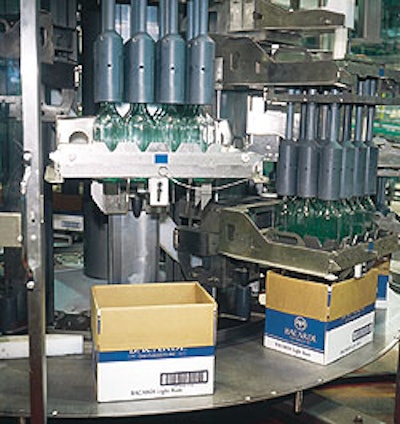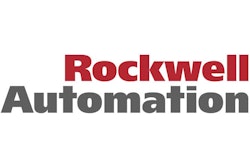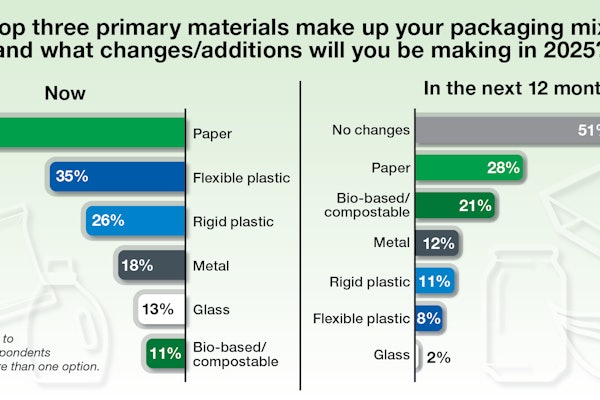Currently capable of churning out about nine million cases of rum and rum-based products each year, the Bacardi Bottling Corp. of Jacksonville, FL, is now in the middle of a major modernization. And why not, says plant operations manager Bob Zahn. “Most of these lines are 20 years old,” he points out.
Line One is a perfect yardstick for measuring the improved efficiencies Bacardi hopes to gain through its upgrades. Dedicated to 750-mL and 1-L glass bottles, the line is designed to fill 400 bottles/min. Its predecessor maxed out at 300.
Operators have been redeployed, too, as sleek new machines now perform many of the repetitive and mechanical chores formerly done by Bacardi personnel. Zahn figures that Line One now requires about half as many people as in the past. Depalletizing is a perfect example. Before the new line was installed, workers depalletized reshippers by hand and placed them on the infeed conveyor of an uncasing machine. Now, a high-level depalletizer from Krones Kettner (Franklin, WI) handles most of the job automatically.
“An operator on a forklift removes two pallets side by side from the trailer at a time and places them directly on the powered roller conveyor that feeds the depalletizer,” says Zahn. “We can accumulate up to seven full pallets, each having seven layers of reshippers.”
After an operator removes stretch film and strapping, the pallets are advanced by powered roller conveyors as needed. Sensors along the way relay pallet position information to the Kettner system’s PLC, an Allen-Bradley SLC 5/03 from Rockwell Automation (Milwaukee, WI). The PLC in turn activates the roller conveyors to advance pallets forward.
Once a full pallet enters the Kettner machine, the top slip sheet is removed automatically by a vacuum pickup arm and stacked in a bin. The pallet is then elevated so that an overhead sweep device can push cases one row at a time onto a right-angle take-away conveyor.
Sighted at Pack Expo
Zahn says he first saw the Kettner equipment at Pack Expo and later went with a Kettner rep to watch the equipment in action at a customer plant. Apparently he liked what he saw. “It’s rated at 60 cases per minute, and it’s really well constructed,” he points out. Two more Kettner depalletizing systems are on their way, he adds.
Also being evaluated is a recently developed system from Pearson Packaging Systems (Spokane, WA) that will automatically remove film wrap and straps. “The equipment is in and running at Coke and Pepsi,” says Zahn. “We’re keeping an eye on how it goes for them.”
Once overhead, cases are conveyed about 150’ until they reach the filling room. The Magneroll™ low-pressure conveyor from Gebo (Bradenton, FL) operates on a magnetic clutch principle that causes the conveyor rollers to halt whenever cases are backed up. This prevents damage to the cases due to friction. Gebo also served as line integrator.
When cases reach the filling room, they descend nearly to floor level and move one at a time into an uncaser (see sidebar) that picks the empty bottles from each case and puts them onto a tabletop chain conveyor leading to the rinser/filler/capper block. The reshippers are then conveyed overhead toward the case packer. But first they pass through an inspection system from Heuft (Downers Grove, IL) that x-rays each case to ensure that no bottle has been left in. Any case with a bottle is rejected.
Uncased bottles are conveyed in a mass and then single-filed by line pressure into a rinser/filler/capper block. Between the uncaser and the infeed of this block, a tabletop conveyor provides about three minutes of accumulation time.
Rinser/filler/capper block
The Italian manufacturer Ave, represented in the United States by Horix (McKees Rock, PA), supplied Bacardi’s rinser/filler/capper block. First is rinsing, performed by 60 bottle grippers that upend each bottle so it can be rinsed. Following the rinse, bottles are uprighted and handed off by starwheel to an 80-head gravity-feed filler. Finally, filled bottles are fed through another starwheel exchange into a 20-head rotary capper that applies roll-on, pilfer-proof caps. Each closure has a breakaway band that provides tamper evidence.
PLC controls allow operators to select container size out of a menu that’s accessed at the human- machine interface touchscreen panel. At the touch of a button, the rinser, filler, and capper all adjust to the new bottle head height automatically, while the rinser and filler automatically adjust the amount of liquid they need to dispense.
“We’ve had equipment from Horix in here for 20 years, so we know that service and quality can be counted on,” says Zahn in explaining one of the reasons this particular portion of the line was selected.
Noticeably absent beside the capper is a cap hopper. That’s because the cap delivery system is far upstream, in the room occupied by the depalletizer. Supplied by Fowler Products (Athens, GA), the system uses a cleated belt to elevate caps onto an overhead belt conveyor that carries them nearly 150’ to the capper.
The idea behind this remote cap hopper concept is to keep the corrugated boxes in which caps are shipped away from the packaging line. This minimizes clutter around the machines and reduces dust as well. But finding a conveying system that would handle the aluminum caps without denting them took more than a little research. Zahn is pleased with the Fowler system and is now adding similar feed machines to other lines in the plant.
Exiting the Ave/Horix block, bottles move through a Heuft x-ray system that causes any bottle with a wrong fill height or missing/cocked cap to be rejected. Then the bottles enter the labeler, which is tightly synchronized with the filler through sensors that deliver information to the line’s central PLC. The filler is essentially a slave to the labeler, so the speeds of each machine are always evenly matched.
In use on the day Packaging World visited was a labeler pulled from another line, a 20-year-old cold-glue labeler from Krones. Soon to be installed, however, is a Krones Multimatic pressure-sensitive labeler. The switch to p-s labels, which typically cost more than glue-applied ones, didn’t come without some serious analysis, says Zahn. But the p-s equipment is cleaner and easier to maintain, says Zahn, which meant a lot.
“Besides,” he adds, “in the case of our labels, they’re going to be pretty expensive either way because they have embossing and gold stamping and such.” When all of this was factored in, p-s was deemed the way to go.
With the arrival of the new labeler, bottles will receive two front labels instead of one. But the Krones machine will have a total of six labeling heads, three primary and three redundant. “If a roll should break, the preloaded redundant head kicks in automatically,” says Zahn. “There’s no downtime.”
On to case packing
As bottles leave the labeler, they’re mass conveyed a distance of about 40’ before rounding a turn that takes them back 40’ in the opposite direction. This 80’ stretch of tabletop conveyor provides about three minutes of accumulation. Then lane guides divide the mass flow of bottles into rows of three, which is just the alignment required by the next piece of equipment in the line, the case packer (see sidebar).
Exiting the case packer, boxes are conveyed through a Pearson system that slits the tabs holding the flaps closed on the reshipper, applies hot melt, and presses the flaps closed. The third and final Heuft x-ray system in the line checks for missing bottles and gross underfills. It also employs sonic sensors to detect case flaps that are not properly closed.
Cases now move toward a spiral conveyor that elevates them to an overhead conveyor leading to remote palletizing. Just ahead of the spiral elevator is a Videojet ink-jet coding system from Marconi (Wood Dale, IL). Cases require date coding on one side only, and they leave the depalletizer upstream without being oriented one way or another. So a pair of bar-code scanners detects which side the imprint target on the case is facing. Once signaled, the coding system knows which ink-jet printer, left or right, should be activated.
As Zahn and colleagues plan the installation of two more new lines later this year, they’re no doubt relying on their experience with Line One to help them shorten the learning curve on the new lines. Also, they continue to refine Line One.
“We’d like to run the entire line with just four people,” Zahn says. “I think we can do it.”
See sidebar to this article: Uncaser, case packer like twins






























